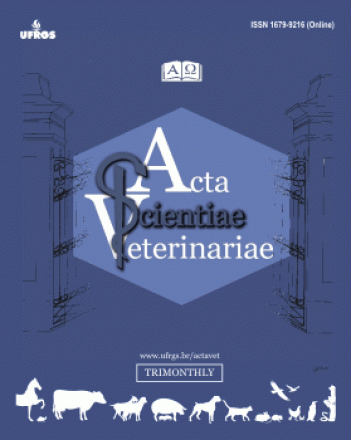Toxicidade do pólen de Mimosa tenuiflora para abelhas (Apis mellifera L.) africanizadas
Acta Scientiae Veterinariae
Toxicidade do pólen de Mimosa tenuiflora para abelhas (Apis mellifera L.) africanizadas
Autor Correspondente: Benito Soto-Blanco | [email protected]
Resumos Cadastrados
Resumo Inglês:
Background: Researches have been developed to observe the normal microbiota of different animal species. This subject is of
major importance for the control of potential infection risks. Fungi can be found in various substrates, foodstuffs (cereals, meat,
milk, vegetables) and also in the skin, mucosae, respiratory and gastrointestinal tracts of animals. With the dissemination of
immunosuppressive diseases in swine herds over the last years, the number of concomitant diseases caused by opportunist
microorganisms is gradually increasing in literature. The objective of this study was to determine the microbiota of pig skin
with no apparent lesions.
Materials, Methods and Results: A number of 261 pigs from 11 swine farms located in six municipalities of the State of Rio
Grande do Sul, in Southern Brazil, were used for the study, in the period from April 2005 to April 2006. After being cleaned with
water and 70% ethanol, skin samples were collected by friction of circular and sterile hair brushes against the posterior ventral
region of the animals, on an area of no more than 10 cm. After sample collection, the brushes were wrapped with the same
aluminium foil used in the sterilization process. Within the next 24 hours, the material was streaked onto agar and incubated
at 25°C to 30ºC for up to four weeks. Micromorphology was used for mold identification purposes, and the process employed
lactophenol cotton blue staining. Whenever an initial identification was not possible due to the absence of characteristic
structures, the isolate would be picked onto Potato agar to stimulate the development of reproductive structures. Yeasts and
yeast-like fungi were characterized by physiological routine assays and differential tests, such as chlamydoconidia production
and germ tube tests, and also by cultivation in HiCrome Agar. Isolates that produced arthroconidia were classified into the
genera Geotrichum or Trichosporon. A number of 501 isolates were obtained, of which 297 were molds and 204 yeasts. Among
the molds, the hyalohyphomycetes prevailed with 211 isolates, followed by 53 pheohyphomycetes and 33 zygomycetes. Two
hundred and four yeast samples were identified as Candida albicans and Trichosporon spp., in addition to other far less
frequent species, such as C. glabrata.
Discussion: The varied range of species isolated from the skin of pigs in this study can be explained by a number of factors,
such as type of management, swine farm installations and environmental variations. The diversity of the microbiota found in
relation to other studies demonstrates the necessity of this kind of research, because knowledge of the prevailing microbiota
in a determined region facilitates the evaluation of potential impacts of sporadic or emerging new fungal diseases in herds,
particularly in immunosuppressed animals. The observation of 17 Scopulariopsis brevicaulis isolates is worth pointing out,
as its presence, associated with environmental and host factors, may favor the infection of pigs and the clinical development
of the Dermatitis in the species. Knowledge of the diversity of mycological agents that are in direct contact with healthy
animals may assist the diagnosis of exotic etiologies, particularly in animals with immunosuppressive diseases, considering
that these are being diagnosed in swine with an increasing frequency.

